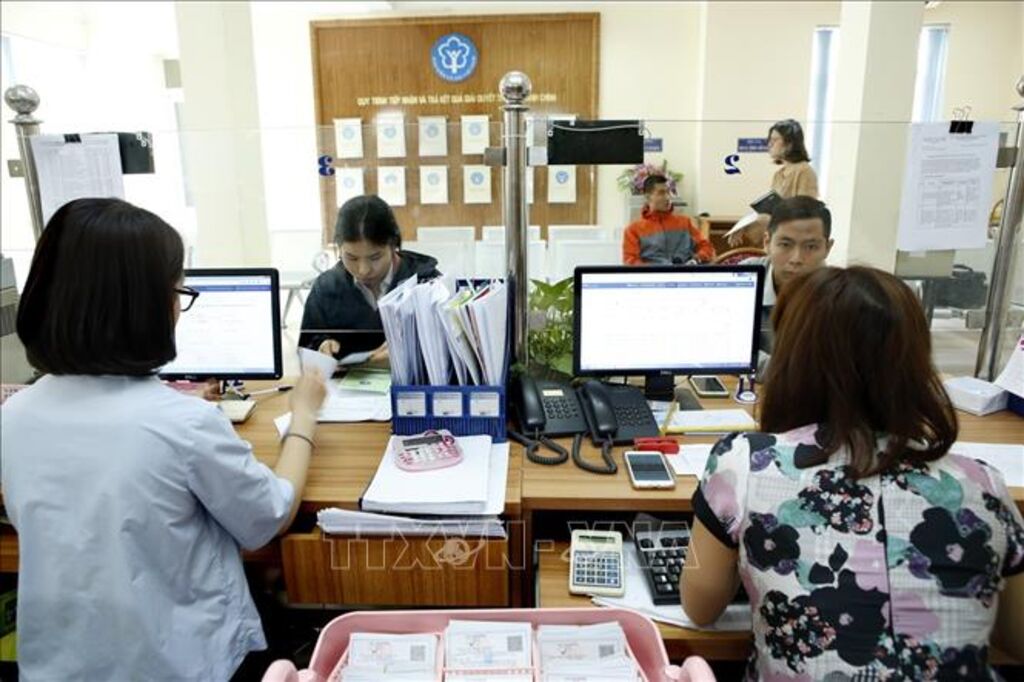 |
| Handling administrative procedures at a social insurance office in Hanoi__Photo: VNA |
Exceptions to social insurance payment evasion effective from November 30
On October 16, 2025, the Government issued Decree 274/2025/ND-CP, detailing several provisions of the Law on Social Insurance regarding delay or evasion in compulsory social insurance and unemployment insurance contributions, as well as regulations on complaints and denunciations in this field. The Decree will take effect on November 30, 2025.
Article 4 of the Decree specifies cases that are not considered evasion when the failure to pay insurance premiums arises from officially declared events related to natural disaster prevention, emergency situations, civil defense, or epidemic control.
These include storms, floods, inundations, earthquakes, major fires, prolonged droughts, and other severe natural disasters that directly and seriously affect business operations; dangerous epidemics officially declared by state authorities that significantly impact employers’ operations and financial capacity; emergency situations under the law causing sudden and unexpected disruptions; and other force majeure events as defined by the Civil Code.
These exceptions aim to ensure fairness for employers facing unavoidable circumstances while maintaining strict oversight of social insurance obligations.
New national economic classification system to apply from November 15
From November 15, 2025, Vietnam will apply a new national economic classification system under Decision 36/2025/QD-TTg, dated September 29, 2025, replacing Decision 27/2018/QD-TTg.
The updated system standardizes sector codes to reflect trends in digital transformation, green economic development, and international integration, and sets out clear principles for using these codes in business registration, investment registration, state statistics, and administrative databases.
Enterprises are required to review and update their registered business codes to ensure consistency and avoid discrepancies in administrative procedures and statistical reporting. The new framework is expected to synchronize national economic data and enhance the effectiveness of policy planning and governance.
Credit institutions to be rated under new criteria from November 1
Circular 21/2025/TT-NHNN of the State Bank of Vietnam (SBV), on the classification of credit institutions and foreign bank branches, will take effect on November 1, 2025. The Circular sets out principles, methods, and criteria for assessing and ranking institutions to ensure the ratings accurately reflect operational performance and risk levels while complying with legal regulations.
Credit institutions and foreign bank branches will be divided into six peer groups: (i) large commercial banks (average quarterly total assets exceeding VND 300 trillion); (ii) small commercial banks (equal to or below VND 300 trillion); (iii) foreign bank branches; (iv) finance companies (including general, factoring, and consumer finance companies); (v) financial leasing companies; and (vi) cooperative banks.
Each entity will be evaluated using both quantitative and qualitative indicators measuring financial soundness, compliance, and management quality. Based on the final score, institutions will be rated A (Good), B (Fair), C (Average), D (Weak), or E (Poor).
Declaration required for gemstones worth from VND 400 million when entering or leaving Vietnam from November 1
Circular 27/2025/TT-NHNN, guiding the implementation of several articles of the Anti-Money Laundering Law, will take effect on November 1, 2025.
A notable provision requires travelers carrying gemstones or precious metals valued at VND 400 million or more (around USD 16,000) when entering or leaving Vietnam to declare and present relevant documents to customs authorities.
The declaration applies to silver, platinum, jewelry or handicrafts made from these metals, alloys containing silver or platinum, and gemstones such as diamonds, rubies, sapphires, and emeralds, as well as negotiable instruments worth VND 400 million or more.
For foreign currencies, Vietnamese dong cash, and gold, declaration thresholds follow existing regulations. Required documents include original or certified invoices or other proof of lawful origin; if issued in a foreign language, they must be accompanied by a certified Vietnamese translation.
This regulation aims to strengthen transparency and anti-money laundering compliance in cross-border asset transactions.
Amended regulations on non-cash payment services
The SBV issued Circular 30/2025/TT-NHNN on September 30, amending Circular 15/2024/TT-NHNN on non-cash payment services. The Circular will take effect on November 18, 2025, except Article 7.2, which will become effective on April 1, 2026.
The new rules strengthen customer identity verification requirements. Accordingly, Vietnamese citizens must present a citizen identity card or level-2 electronic identification (eID) when using payment services. Meanwhile, foreign residents in Vietnam must present a passport, equivalent document, or level-2 eID.
The Circular also tightens the responsibilities of payment service providers in complaint handling and violation reporting, while requiring that online payment systems not experience interruptions exceeding four hours per year.
If disruptions last more than 30 minutes or maintenance occurs without prior notice, payment service providers must report to the SBV within four hours and submit a detailed report within three working days.
The regulation aims to enhance safety, reliability, and transparency in electronic payments in line with the national digital transformation strategy.
Banks allowed to deliver and receive gold bars from November 15
On September 30, 2025, the SBV issued Circular 33/2025/TT-NHNN, amending Circular 17/2014/TT-NHNN on the classification, packaging, and delivery of precious metals and gemstones. The new Circular will take effect on November 15, 2025.
 |
| Under Circular 33/2025/TT-NHNN, credit institutions are permitted to deliver and receive gold bars under purchase, sale, or processing contracts__Photo: VNA |
Accordingly, credit institutions are permitted to deliver and receive gold bars under purchase, sale, or processing contracts. All deliveries must comply with regulations, be properly sealed and accompanied with required documentations.
The Circular classifies gold into three categories: jewelry and fine-art gold (purity of 8 karats or higher); gold bars (with clear serial numbers and specifications); and raw gold (in ingot, grain, or sheet form).
Packaging and sealing requirements have also been tightened. Gold bars of the same quality must be packaged in lots of 100 or multiples thereof (up to 500 bars), while raw gold must be packed in lots of 5 or multiples thereof (up to 25 ingots), using non-corrosive metal containers that are sealed and clearly labeled. Particularly for gold bars, packaging must include anti-counterfeiting features in line with standards set by licensed commercial banks or authorized gold producers.
The regulation aims to ensure standardization, traceability, and security in gold trading and management within the banking system.- (VLLF)









